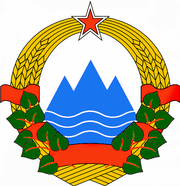History of Slovenia
|
|
| Contents |
Ancient times
In ancient times Celts and Illyrians inhabited the territory of present-day Slovenia. The Roman Empire established its rule in the region in the 1st century, after 200 years of fights with the local tribes. The most important ancient Roman cities in this area included: Celeia (now Celje), Emona (Ljubljana), Nauportus (Vrhnika), Poetovio (Ptuj).
Karantania
Karantania_597.png
The very first Slavic and Slovenian state, Karantania, mainly occupied the territory of today's Austrian Carinthia and Slovenian Carinthia. The early history of the Karantanian state remains unknown. One hypothesis suggests that this state emerged in the 6th century, once the Lombards moved west and invaded northern Italy. Karantania definitely already existed in the 8th century. In 746 Karantania became dependent on the Bavarians.
German domination
From as early as the 9th century, the lands inhabited by Karantanians, later Slovenes, fell under non-Karantanian ruler, including partial but co-operative control by Bavarian dukes and by the Republic of Venice.
The Slovenes living in the provinces of Carinthia, Carniola and Styria, lived under the rule of the Habsburg dynasty from the 14th century until 1918, with the exception of Napoleon's 4-year tutelage of parts of modern-day Slovenia and Croatia — the "Illyrian provinces".
While the elites of these regions mostly became Germanized, the peasants strongly resisted Germanizing influences and retained their unique Slavic language and culture. After some flirtation with the Reformation in the 16th century, the region became re-Catholicized under the rule of Archduke Ferdinand of Inner Austria (ruled 1590 - 1637), who later became Emperor and pursued similar policies in the other Habsburg territories. See also: Croatian and Slovenian peasant revolt of 1573.
In the 19th century intellectuals codified Slovene into a literary language, and Slovene nationalist movements began to take hold, initially demanding Slovene autonomy within the framework of the Habsburg Monarchy.
20th century
In 1918, after World War I, the Slovenes joined with other southern Slav peoples in forming the State of Slovenes, Croats and Serbs 29 October 1918) and then the Kingdom of Serbs, Croats and Slovenes (1 December 1918) under King Peter I of Serbia. Renamed in 1929, the Kingdom of Yugoslavia fell to the Axis powers during World War II, when Germany and Italy each annexed parts of Slovenia.
Following Yugoslav partisan resistance to German, Hungarian, and Italian occupation and elimination of rival resistance groups, Josip Broz Tito established in 1945 the Socialist Federal Republic of Yugoslavia, of which Slovenia formed a constituent republic.
Slovenia continued to form Yugoslavia's most prosperous and advanced republic through the communist era, at the forefront of Yugoslavia's unique version of communism. Within a few years of Tito's death in 1980, Belgrade initiated plans to continue concentrating political and economic power in its hands. Defying the politicians in Belgrade, Slovenia embraced democracy and opened its society in the cultural, civic, and economic spheres to a degree almost unprecedented in the communist world. In September 1989, the General Assembly of the Yugoslav Republic of Slovenia adopted an amendment to its constitution asserting Slovenia's right to secede from Yugoslavia.
On December 23, 1990, 88% of Slovenia's population voted for independence in a referendum, and on June 25, 1991, the Republic of Slovenia declared its independence. A nearly bloodless 10-day war with Yugoslavia followed (27 June 1991 - 6 July 1991); Yugoslav People's Army forces withdrew after Slovenia demonstrated stiff resistance to Belgrade.
Historical ties to Western Europe made Slovenia a strong candidate for accession to the European Union and NATO. It became a member of NATO in March 2004 and joined the European Union on May 1 2004.
See also
- Timeline of Slovenian history.
- Habsburg Monarchy
- History of the Balkans
- History of Austria, History of Italy, History of Hungary, History of Croatia, History of Yugoslavia, History of Germany, History of the Czech Republic, History of Slovakia.
Reference
- Janko Prunk, A Brief History of Slovenia, Grad, Ljubljana 1996
| Former Yugoslavia (SFRY) | Missing image Flag_of_SFR_Yugoslavia.png Flag of the SFRY |
|---|---|
| Republics | |
| Bosnia and Herzegovina | Croatia | Macedonia | Montenegro | Serbia | Slovenia | |
| Autonomous provinces of Serbia | |
| Kosovo | Vojvodina | |
bg:История на Словения de:Geschichte Sloweniens es:Historia de Eslovenia lt:Slovėnijos istorija sl:Zgodovina Slovenije



